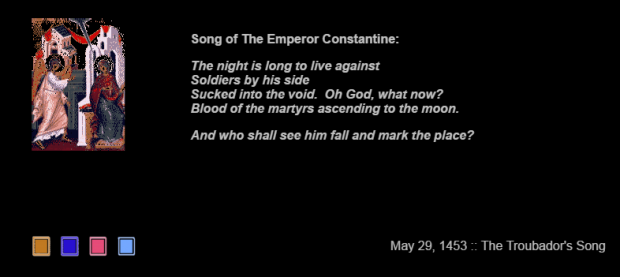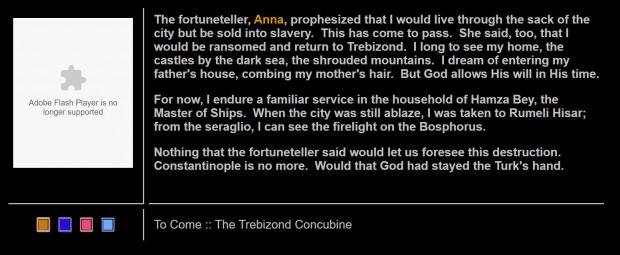Pyxis Byzantium
Pyxis Byzantium is a hypermedia narrative investigation into the fall of Byzantium in 1453. Surrounded by enemy forces for decades, the final invasion of the city was widely anticipated by some of the populace, denied by others, and a focus of wonder and prayer. This piece imagines several different residents of the city, their fears and hopes, and their beliefs about the sources of destiny. The navigation includes maps of the city, sacred holidays, and the chronology of the destruction. Because of its extensive use of Flash, it is not currently playable in original form.
Artist's Statement:
Pyxis Byzantium was inspired by a visit to Turkey and extensive research into the Byzantine Empire. Pyxis means ‘little box” in Greek – and this work is a medieval treasure-box of visions of the collapse of Byzantium. The victory of the Turks changes the course of history not only in the area, but across the globe. And yet, at the moment of crisis, records show that the great city of Byzantium was divided, confused, and ill-prepared. This work continues my interest in hypermedia narrative, the layering of history and place, the blending pf public and private, invented, events.
From 2008 ELO Media Arts show:
It is also, though, about the destruction and loss of other civilizations. What persists in the human story is the structure of decline and defeat—the narrative of predictability and surprise that accompanies the loss of a culture. The people of Byzantium sit impotent inside their walls much as the ancient Romans did, and much as we, even today, do when we are threatened with world-changing events. The "layout" of the piece—the narrative access—is a map of Byzantium. But, in addition, the word Pyxis means "little box" in Greek. Thus, the architectural structure of this work is like one of those complex, little Byzantine painted ivory cases with boxes and boxes nested inside. To read the piece, one needs to keep mousing over and clicking on the images, moving from illuminated scene-box to scene box. Any screen which seems to have no clear place to click will reveal new things wherever you click or mouseover. If you are eager to move to another “scene,” all you need to do is mouse over the screen to find another "box" to open. The story will continue.
As such, *Pyxis Byzantium* represents both familiar aspects of my work over the years and new challenges in framing material story with imaginary time. This work is an experiment in fusing the coding/architecture/shape of the electronic work with the actual materiality of the landscape, the natural phenomena, and the presence of time in place.







